FRANCOIS XAVIER TOURTE 1820 - 25
Only six. The father of our discipline, Francois Xavier Tourte, has not made many bows, but only six are those ones that reached us today. Here I show just one, probably the most beautiful among them.

Viola bow Francois Xavier Tourte 1820 - 25
Before describing this wonder, I would like to thank the person who gave me the opportunity to take a photo of it . He is a musician of a very high level and a human being with a such a noble soul and honesty that are difficult to meet. Think that when he gave me this bow, plus a magnificent Dominique Peccatte, to take pictures, I kept them for a day. Given the confidence in me and the great importance for my work to have in store pieces of this level, I thought it was right to reciprocate the kindness by asking M° Navea Vera to carry out a rehairing, obviously asking his prior authorization. The day after , when I brought him the bows back, before greeting he has asked to speak a moment with me privately. We left the classroom full of students where he was giving a lesson and out of the door he said, literally "Paul, thank you for the reharing but I do not like to leave any work unpaid . Please tell me how much I owe you. "
Judge for yourself, most of these great names, do not even say "thank you" whenever you make something kind for them !

As mentioned above, this bow is not only an absolute rarity, it is the physical demonstration of the immense manuality level and, above all, of the working concept of this craftsman.
We start for example by the choice of the material. After the brainwashing that has been done for one hundred and fifty years to the musicians about the idea that the dark wood sounds better, you now see a small revival, but this nonsense is still widespread. But who has put out this story and why?
The story has obviously been endorsed by a whole generation of bowmakers / small factory like Bazin or Morizot, producing bows in series and the reason why they used these woods is quite simple. They are usually very hard to work, even when they are new they give a sound that some mistake for soft, and given the low elasticity, they are also comfortable to play. The only problem they have is that they are audible only until a distance of three meters, no further.

I know that many of you may disagree with me, but looking at the production by Francois Xavier Tourte, it seems that at least he was.
The material of this bow is a clear example, but is not an exception, all his works tends to the light wood and not a very dense one and the reason is simple. He wanted the bow to play and as the percentage of wood that plays is much higher in the light shade, he used it and the result was just the confirmation that his idea was really a right one as it can be heard even today after two hundred years.

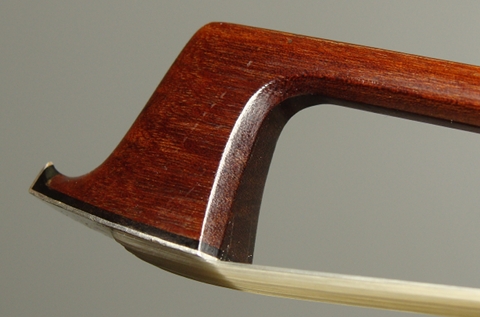
The bow, as eighty percent of its production, has an octagonal section and the processing of the stick has revealed to me what were the tools used. Today, the French school uses very small planes and with the nail of the blade in a very inclined way in order to remove large quantities of wood at each stroke.
If this tool, on one hand, speeds up the work, on the other hand it makes the work on the stick as very irregular. In fact, when you watch a bow worked with this tool, you can see sort of bumps alongside the whole stick . This happens because the iron plane is very tilted and in general the tool is too light so when it is planed it fails to stretch the wood fiber in a proper way.
This owns a perfect making of the stick . The faces of the octagon are drawn, clear and clean, this means that he used a tool more similar to our screed, heavy and with the blade set at ninety degrees on the stick.
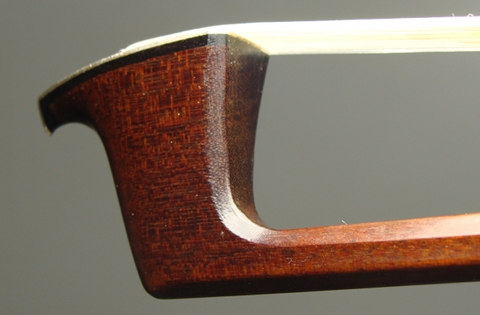

He as well, like Dominique Peccatte has his own "S"

As you can see, the work in general is much more refined and precise, but he, as well, had some points of which he cared less and the line of the wedge is one of them. Here, the "S" even if less protruding, it is double and it is done like that because, in this way, he could hardly hide a major flaw with a smaller one , giving the impression of being straighter.
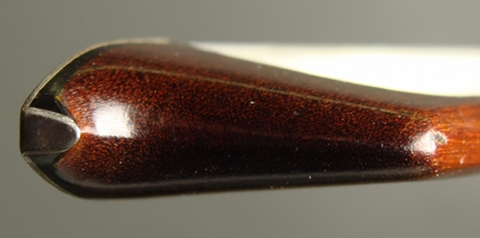
The house and the fiber give us the idea of what was level of the sophisticated style of this author. Having put on the metal shoe, the length of the house comes out to be too short and this caused not having enough space to have a slim profile at the top of the head. In other bows I have seen, probably earlier than this one, he tries to solve the problem by lengthening the wood, but the result is not satisfactory, he gets a head that is too unbalanced forward. In this case the trick is brilliant. He replaces the missing thickness by stretching the ebony, thus creating space to properly allow the lines to release and thanks to the different color of the ebony, it doesn't unbalance the head and creates a much more attractive geometry while watching it as in the picture below .

The metal shoe is fastened with two small nails similar to those used for the frog and since he lived near a former jeweler, now bowmaker , maybe he built it ...
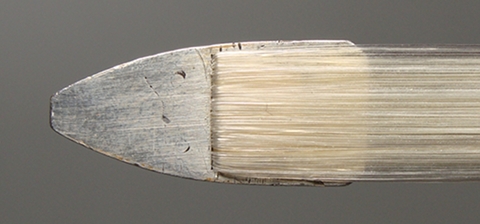
Even this bow has the a copy of the frog and in this case it is more than justified. Tourte has rarely used the metal coulisse which protects the octagon, and consequently, the frogs are very fragile.

Specifications and sizes
Stick: pernambuco of medium density in light brown colour; ancient curve and radial cut.
72,9 cm total length, i.e. 72,48 cm stick, 1,65 mm nipple, 2,55 mm housing
Stick diameter at the collar 5,95 - 5,7 mm
Stick diameter at the wrapping 9 - 8,6 mm
Heel mortice 16 mm (from 14,8 to 30,8)
Head: width 11,3 mm, height 23,5 mm (24,75 with shoe and fibre), length 22,3 mm (24,7 with shoe and fibre)
Weight: 70 gr.
Even this week I had some fun with photo-retouch, if you wish click, download and print it !
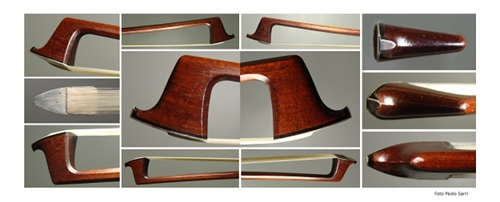
So long.
Paolo
|
 
 |